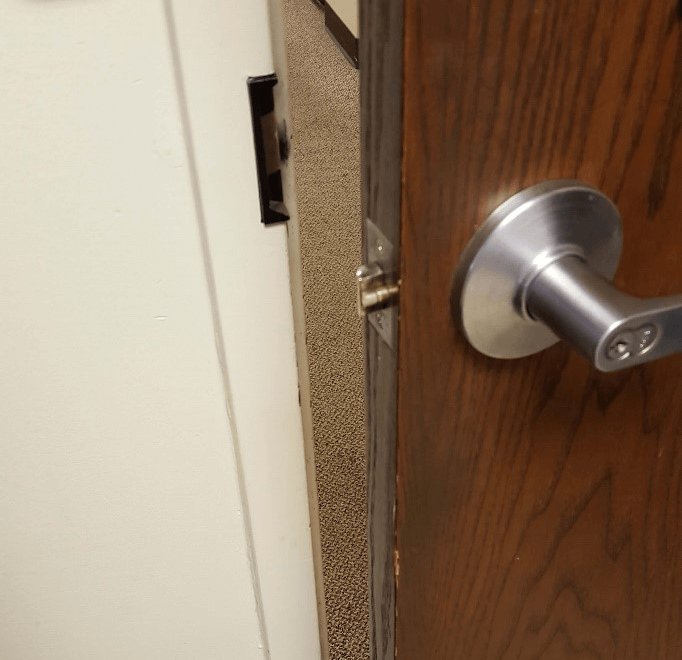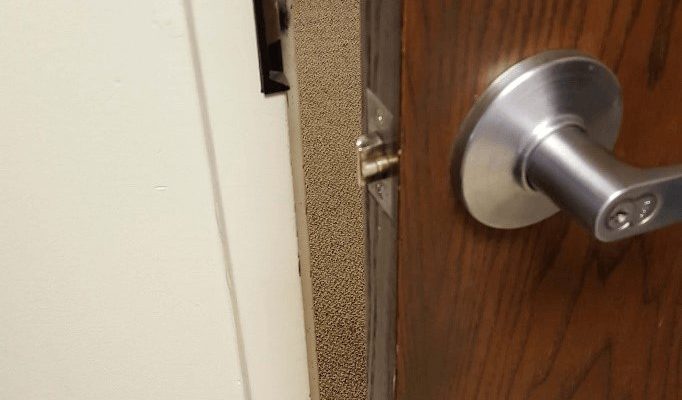
Here’s the thing: deadbolts are designed with this extra plunger for a reason, and when it doesn’t move or pop out as it should, your whole lock loses a chunk of its security. I’ve seen folks with Schlage, Kwikset, and Baldwin locks (all big-name brands) run into this exact problem. Maybe you’re dealing with a sticky plunger, or it doesn’t move when you close the door, or it just feels “off” when you turn your key. Let’s break down why your deadbolt’s deadlocking plunger might not be functioning, how to troubleshoot it, and what you can do about it.
What Is a Deadlocking Plunger and Why Does It Matter?
Let me explain what this little metal piece actually does. On modern deadbolts—think about brands like Schlage, Kwikset, or Yale—there’s often a small spring-loaded rod or plunger next to the main bolt. When you close your door and lock it, this plunger should be pressed in by the strike plate on your door frame. When it’s pushed in, it prevents the bolt from being retracted unless the key or the thumb turn is used inside.
The main job of the deadlocking plunger is to stop thieves from “loiding” or pushing back the bolt with a credit card or a thin piece of plastic. When it’s working right, even if someone wedges something between the door and the frame, they can’t force the bolt back because the plunger blocks it internally.
You might be wondering: does every deadbolt have this? Not always. Some older deadbolts or very cheap models skip it entirely. But on most modern, residential-grade locks, especially those from major brands, you’ll see it as a thin second rod riding along with the bigger deadbolt.
If the deadlocking plunger isn’t doing its job, your lock is nowhere near as secure as you think—no matter how solid the rest of the hardware looks.
Common Reasons the Deadlocking Plunger Isn’t Moving
Sometimes, the deadlocking plunger fails because of something simple; other times, the issue runs deeper. Honestly, you can usually narrow it down to a few key causes:
- Misaligned strike plate: If the hole in your door frame (the strike) doesn’t line up perfectly with the plunger, it might not get pressed in when the door closes. That tiny misalignment is all it takes to mess up the function.
- Sticky or dirty mechanism: Years of dust, debris, or pet hair can work their way into the lock, making the plunger stick or jam.
- Worn-out internal springs: These springs are what push the plunger back out. Over time (especially if you slam doors or use the lock a lot), they can weaken or break.
- Incorrect installation: If someone swapped out a lock and didn’t align everything perfectly, the plunger might get trapped or not move freely.
All of these boil down to one problem: if the plunger can’t move in and out as designed, your deadbolt’s security feature just doesn’t work. You’ll usually notice this first when the bolt feels “funny” or you have to jiggle the key more than usual.
How to Test If Your Deadlocking Plunger Is Working
You don’t need fancy tools to check this. Here’s a quick way to test your plunger—seriously, you can do this in under a minute.
- Open your door and extend the deadbolt using the key or thumb turn. You’ll see the main bolt and the smaller plunger next to it.
- Hold the bolt so the plunger is not pressed in. Try gently pushing back on the main bolt. If it slides back easily, that’s normal—the plunger is not doing its job because it’s not activated yet.
- Now, use a finger or something solid (like a pencil) to press the plunger in. While holding it, try to retract the main bolt again. If the bolt won’t move or it’s a lot harder to push, then the plunger is working.
- If there’s no change—or you can easily push the main bolt back regardless—the plunger isn’t doing its job.
This test works on almost all standard residential locks, whether they’re Schlage, Kwikset, Baldwin, or something else.
Misalignment: The Most Common Culprit
Here’s where things get practical. If your deadlocking plunger isn’t working, nine times out of ten, the issue is alignment. When a door or the strike plate shifts even a couple of millimeters—maybe from humidity, slamming, or settling—the plunger can miss its mark.
Let me paint the picture: the deadbolt and plunger are supposed to slide smoothly into the holes in your door frame. If the strike plate (the metal bit on the frame) isn’t positioned so the plunger gets pressed in every time, that feature turns off. You’d be surprised how often this happens after someone installs a new deadbolt or after a big weather change.
What to check:
- Does the door latch smoothly without extra pressure?
- Are there scrape marks or shiny spots around the holes in the strike plate?
- If you close the door slowly, can you see whether the plunger actually hits the plate?
If the holes don’t line up, you might need to adjust the strike plate—sometimes moving it up, down, or sideways makes all the difference. Don’t just force the door closed and hope for the best; that’ll only wreck the lock or the plunger over time.
Internal Gunk and Wear: The Hidden Enemies
Let’s talk about what’s happening inside the lock. Over the years, especially on locks exposed to the elements or on high-traffic doors, dust, grime, and old grease build up. That build-up can gum up the plunger’s tiny moving parts, making it sticky or sluggish. It’s a bit like when you get sand in a zipper—everything just stops moving the way it should.
Another common problem? Worn or broken springs. Every time you turn your key or thumb turn, little springs help push the plunger out and pull it back in. If those springs get tired (and trust me, they eventually do), the mechanism just lags or fails. Suddenly, the deadlocking plunger won’t pop out and do its job, and the main bolt’s “snap” feels mushy.
Troubleshooting tip: If everything looks okay visually, but you notice the plunger feels tight, sticky, or lazy, you can often free it up with a squirt of dry lubricant (never WD-40—it attracts more gunk). If that doesn’t help, the lock might be getting old, or the springs are shot. At that point, a rebuild or replacement is usually the fix.
Installation Issues and User Error
You’d be shocked how many deadbolts are installed incorrectly—by both DIYers and even some pros trying to rush the job. Here’s the thing: if the deadbolt and plunger aren’t perfectly straight, or if the holes in the frame aren’t deep and clean enough, something’s going to get jammed up.
If you’ve recently replaced your deadbolt or had new doors fitted, you might run into this exact problem. Maybe the installer didn’t check the depth of the strike plate holes, or the lock is slightly off-kilter so the plunger gets caught on the edge. Sometimes, swapping between brands—say, installing a Schlage deadbolt where a Kwikset used to be—means the size or spacing is just a tiny bit off.
Solution: Slow down and check for:
- Is the plunger sticking out evenly when the bolt is thrown?
- Do the bolt and plunger move smoothly together?
- Is there any resistance as you turn the key?
If you spot any issues, removing the lock, cleaning up the holes, and reinstalling carefully usually helps—just make sure you follow the manufacturer’s instructions, and double-check the alignment before you finish tightening everything down.
Brand Differences: Schlage, Kwikset, and Others
Not every deadbolt is built the same way. For example, Schlage deadbolts often use a thicker, sturdier plunger, while some Kwikset designs are a bit more compact. Higher-end brands like Baldwin or Emtek sometimes add extra features, like anti-pick pins or differently shaped plungers.
Why does that matter? Well, some brands are more forgiving of little alignment errors, while others are sensitive and might get jammed from a tiny misplacement. Also, if you’ve switched from one brand to another without changing the strike plate, the fit can be just off enough to cause problems.
If you suspect your brand is the culprit, check the manufacturer’s website for installation diagrams. Sometimes, just seeing how the plunger should sit against the strike plate is enough to spot your error. Remember that universal replacement parts aren’t always truly universal, especially when it comes to these tiny, precise mechanisms.
What To Do When the Deadlocking Plunger Still Won’t Work
Alright, let’s say you’ve checked the alignment, cleaned out the mechanism, lubed everything, and it’s still not budging. Here’s what I’d do next:
- Disassemble and inspect: Remove the lock from the door and check the plunger’s movement outside the frame. If it’s still stuck, the problem is inside the lock, not with the door.
- Reset or replace: With some locks, you can reset the spring position or swap in new springs if you’re handy with small parts. For most folks, though, replacing the deadbolt is faster and safer.
- Upgrade if needed: If your deadbolt is old, worn out, or a cheap model, now might be the perfect time to upgrade to a better, more secure version. Honestly, the peace of mind is worth it.
- Call a pro: If you’re just not sure or the lock is expensive, a locksmith can usually diagnose, reset, or repair the plunger in minutes.
Don’t: Force the mechanism, jam more lubricant, or ignore the problem. A deadlocking plunger that doesn’t work leaves your deadbolt way less secure, and all that heavy-duty security becomes almost pointless.
Simple Steps to Keep Your Deadlock Plunger Healthy
A little maintenance goes a long way. Here’s how to keep your deadbolt’s deadlocking plunger working smoothly for years:
- Regular cleaning: Once a year (or more if your door faces lots of dust or humidity), remove the deadbolt and brush out any dust or debris. Avoid harsh chemicals—just use a dry brush or compressed air.
- Proper lubrication: Use a graphite-based or dry-lock lubricant every six months. Avoid oil-based sprays; they attract dust and make things worse long-term.
- Routine testing: Do a quick plunger test any time you notice the lock feeling stiffer or the key turning harder. Catching problems early prevents headaches later.
- Check alignment: After any new door installation, lock replacement, or a big season change (like after a wet spring or hot summer), double-check the lock and strike alignment. Doors swell and shift more than you’d expect.
Think of it as a quick “health check” for your home security—simple, easy, and way better than dealing with a stuck or broken lock during an emergency.
Bringing It All Together
When your deadbolt’s deadlocking plunger isn’t functioning, it’s usually something minor—a bit of misalignment, dirt, or wear. But even little issues can make a big difference in your home’s security. If you take a few minutes to check the basics, you’ll usually spot the problem fast. Whether you’re working with a classic Schlage, a handy Kwikset, or another popular brand, the basic ideas are the same: alignment and cleanliness matter, and those little springs and plungers do a lot of heavy lifting.
Keeping your deadlocking plunger in good shape doesn’t take much effort, but it pays off in peace of mind every time you lock your door. If you ever get stuck, you’re never more than a quick call to your local locksmith or a handy friend away from getting it sorted. After all, your lock is only as good as the tiny pieces working behind the scenes—so give them a little attention, and your security will thank you.
